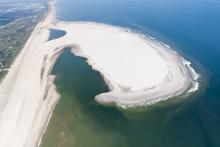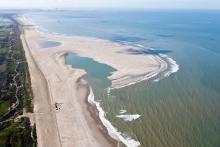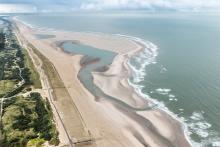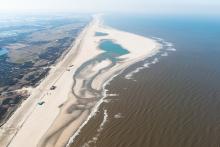A new form of beach nourishment is the 'Zandmotor' (sand-motor) undertaken in the Netherlands. Instead of having smaller nourishments in a time period of 4 to 5 years, the water authority Rijkswaterstaat formed 21.5 million m3 of sand into a peninsula near Ter Heijde in 2011. In the beginning, the peninsula stretched 1 km into the sea and was about 2km wide. The idea is that waves, current and wind spread the sand along the coast and thus enhance the coastal protection and at the same time create a dynamic natural and recreational area. It was expected to have a repeating interval of only 15-30 years.
There is an extensive research program implemented to monitor the success and effects of the sand motor. From August 2011 to February 2014 a total of 2.5 million m3 of sand has been moved and the shape of the sand motor has already changed. A relatively larger amount of sand than expected has been moved in the early days of the measure. This is explained by the artificial shape of the motor at that time and several storms in the first winter accelerated the sand movement.
Technical feasibility
Upon construction The Sand Motor is a hook shaped peninsula, created by moving millions of cubic meters of sand. Gradually the sand will spread partially to both sides and nourish the beach with new sand.
Political & social feasibility
There is considerable foreign interest in the Sand Motor with study requests coming from several European countries as well as from South Africa, Vietnam, The United States and Indonesia.
Cost of implementation & maintenance
In total the implementation of the pilot measure costs 70 Million €, meaning 3,25€/m3 (Fröhlich & Rösner 2015).
Ecological feasibility
On the basis of the initial observations, the researchers notice that more habitats have been created for flora and fauna as a result of the arrival of the Sand Motor. The Sand Motor has proven appealing for a range of outdoor activities, especially kite surfing.
The Sand Motor, as innovative example of building with nature, avoids repeated disruption of the vulnerable seabed and creates a new habitat for flora and fauna as well as a touristic sight. If the pilot project proofs successful in the long run, the intervals of sand replenishments can be reduced to up to several decades.













